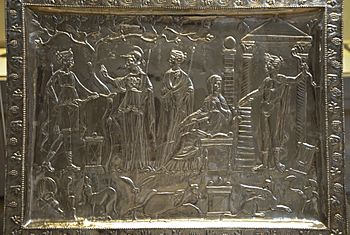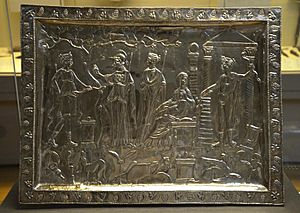Corbridge Lanx facts for kids
Quick facts for kids Corbridge Lanx |
|
|---|---|

The Corbridge Lanx as displayed in the British Museum
|
|
| Material | Silver |
| Size | Length 50.3 cm, Width 38 cm, Weight 4.6 kg |
| Created | 4th Century AD |
| Discovered | 1735 |
| Present location | British Museum, London |
| Registration | 1993,0401.1 |
The Corbridge Lanx is a special silver dish from Roman times. It was found in 1735 near a place called Corbridge in northern England. This dish was once part of a big collection of Roman treasures. Today, only this silver dish remains from that original discovery. The British Museum bought it in 1993, and you can see it there.
How It Was Found
In 1735, a young girl made an amazing discovery. She was the daughter of a local cobbler, someone who makes or fixes shoes. She found this silver dish on the banks of the River Tyne. This river flows near the village of Corbridge in Northumberland, England.
Around that time, many other silver objects were found in the same area. These items were likely part of a large Roman hoard. A hoard is a hidden collection of valuable things. Sadly, all the other treasures from this hoard disappeared over time. Only the Corbridge Lanx survived.
The dish then belonged to the powerful Dukes of Northumberland. It stayed in their family for a very long time, until 1993. That year, Henry Percy, 11th Duke of Northumberland sold it to the British Museum.
What It Looks Like
This large silver tray is shaped like a rectangle. It has beautiful pictures carved into it. These pictures show scenes from old Roman stories about gods and heroes.
People think this dish was used in two main ways. It might have been a serving dish for big Roman banquets, which were fancy feasts. Or, it could have been a special tray used for sacrifices. Sacrifices were religious ceremonies where people offered gifts to their gods.
The Corbridge Lanx is very fancy and well-made. It looks similar to other large silver platters found in a famous collection called the Mildenhall Treasure. Experts believe it was made in the 4th Century AD.
The main picture on the dish shows the god Apollo. He is standing at the entrance of a shrine, which is a holy place. Apollo is holding a bow, and a musical instrument called a lyre is at his feet. To his left, two goddesses are walking in and talking. These are Artemis and Athena.
There are also two other female figures in the middle of the dish. Experts are not completely sure who these two goddesses are. In front of the gods, there is an altar. An altar is a special table used for religious ceremonies. Next to the altar, you can see Artemis's hunting dog, a deer that has fallen, and a griffin. A griffin is a mythical creature with the body of a lion and the head and wings of an eagle. Griffins were often linked to the god Apollo.


